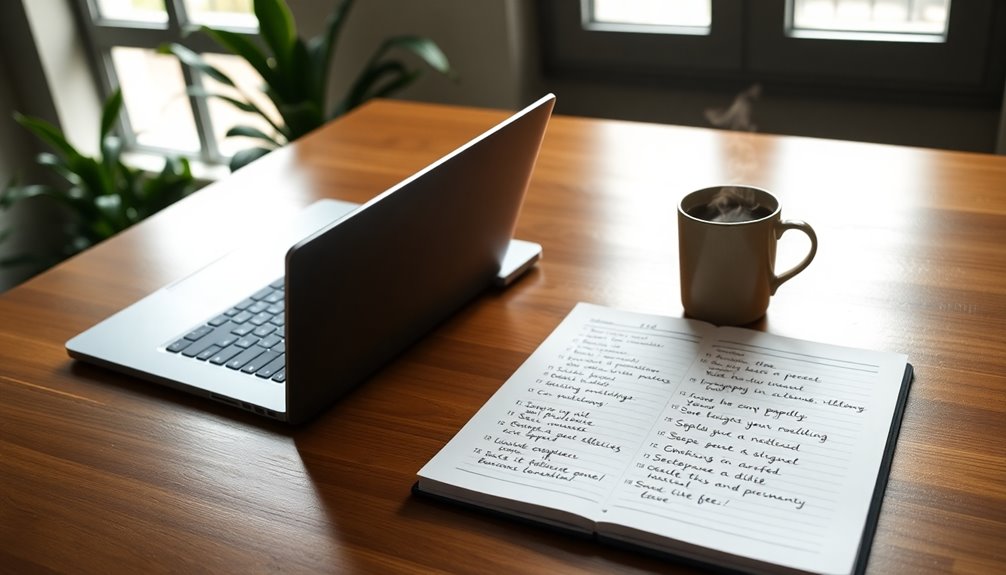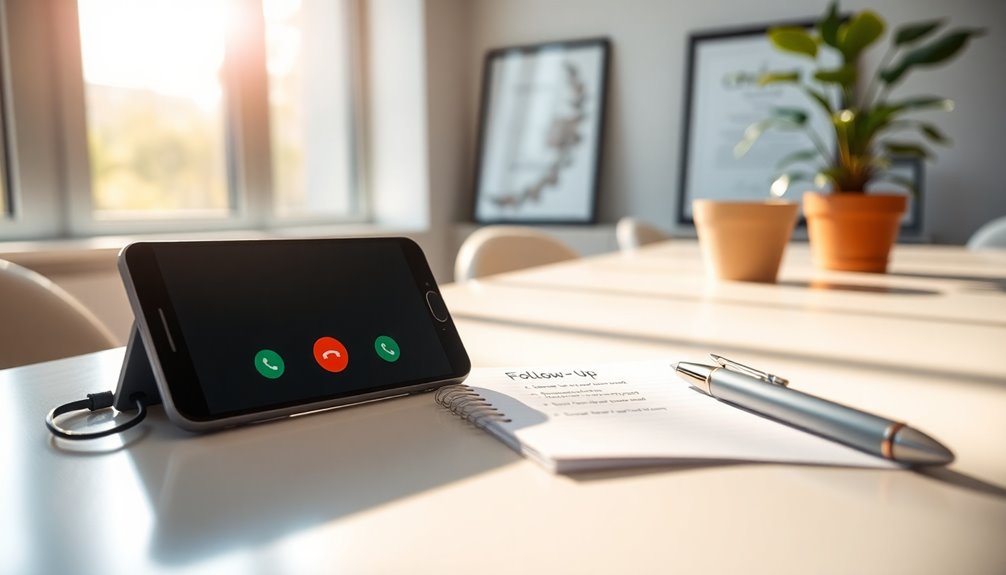To create a follow-up email that gets results in 24 hours, start by addressing your recipient personally and referencing past interactions. Keep your subject line concise and engaging to boost open rates. Aim to follow up 2-3 days after your initial contact. Clearly outline next steps and add value with relevant insights or offers. A strong, action-oriented call to action will guide your recipient toward a response. Remember, analyzing engagement metrics can refine your approach. Discover how to make your follow-ups even more effective and enhance your email strategy to achieve ideal results.
Key Takeaways
- Personalize your subject line with the recipient's name to increase open rates and grab attention instantly.
- Include a clear call to action (CTA) that outlines the next steps you want the recipient to take.
- Reference past interactions to create a connection and show genuine interest in the recipient's needs.
- Keep your email concise and structured, using bullet points to summarize key information for easy readability.
- Follow up within 2-3 days of the initial contact to maintain momentum and increase the chances of a response.
Importance of Follow-Up Emails
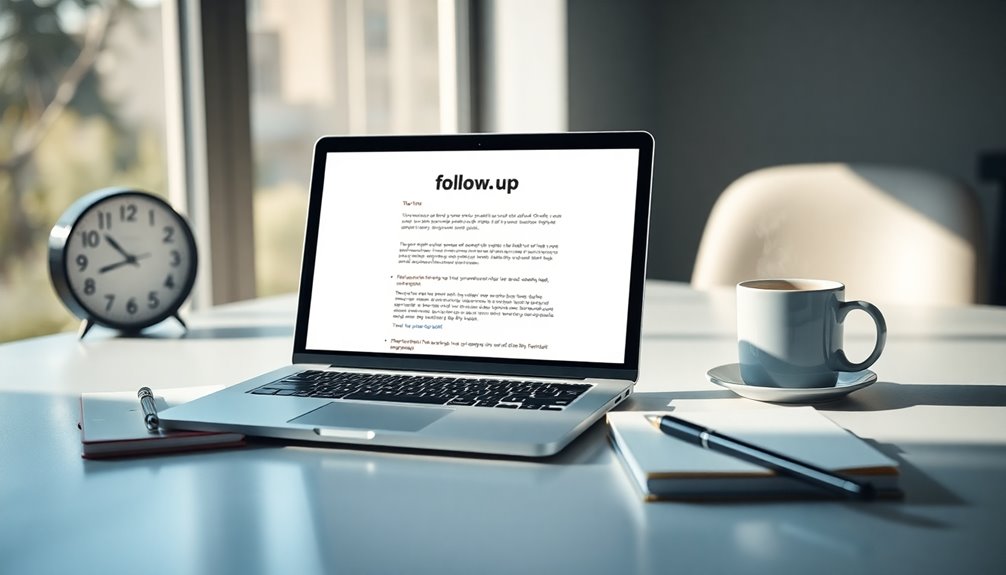
Follow-up emails are vital not just for closing deals but for nurturing relationships with your customers. When you send a follow-up, you show appreciation for their business and express genuine interest in their satisfaction. This simple act helps build trust over time, making customers feel valued and cared for.
By addressing their questions or concerns, you enhance customer satisfaction, which leads to increased loyalty. Customers who feel supported are more likely to return and recommend your services to others.
Additionally, follow-up emails can revive old relationships and keep lines of communication open, ensuring that your business remains top of mind. Your follow-ups can also provide added value, like exclusive offers or informative content, which engages prospects and encourages conversions. This is especially important as the ideal waiting period for follow-ups is typically 2 to 3 days after the initial contact.
They help clarify doubts about your products or services, making it easier for customers to make purchasing decisions. Ultimately, sending follow-up emails sets you apart from competitors.
You demonstrate professionalism and a commitment to your customers' needs, which can differentiate your business. So, don't underestimate the power of a well-timed follow-up—it's an essential component of building lasting customer relationships.
Ideal Timing for Follow-Ups
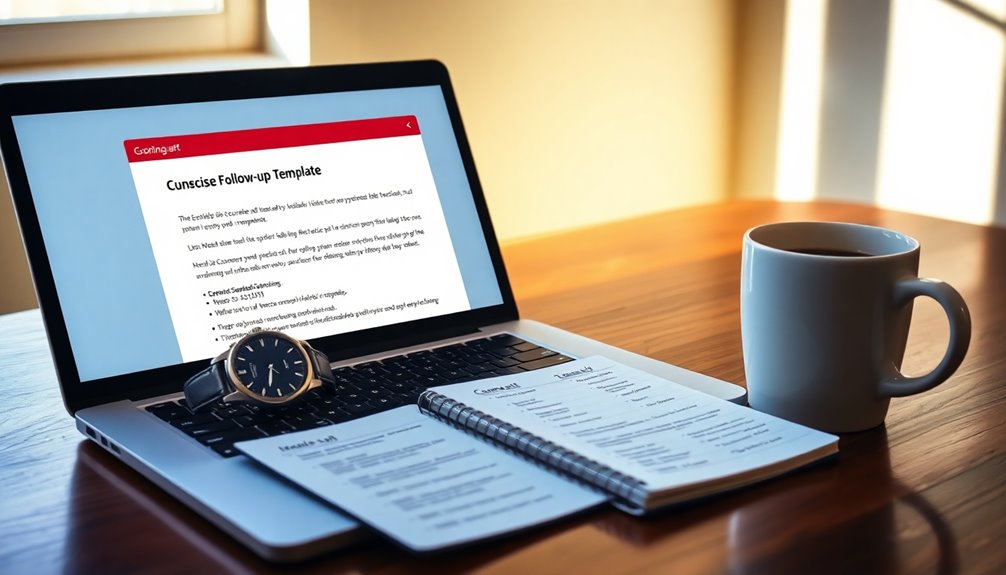
Timing's essential when it comes to follow-up emails.
You'll want to take into account ideal time intervals and adjust your approach based on the recipient's response. Consistent follow-ups can significantly increase the likelihood of receiving a response, as 80% of non-routine sales occur after five or more follow-ups. Additionally, understanding emotional intelligence can help tailor your follow-up strategy to resonate better with the recipient.
Optimal Time Intervals
When considering the ideal time intervals for follow-up emails, it's important to strike a balance between patience and persistence. Start by waiting at least 2 to 3 days after your initial email. Holding off for around 4 business days can also be effective, as it gives your prospect enough time to respond without feeling pressured. Sending too soon can lower your response rates, so be mindful. For subsequent follow-ups, aim for a rhythm of every 3 to 4 days. If you need to reach out multiple times, gradually increase the waiting period. In some cases, spacing your follow-ups a week apart works well, while for high-level executives, consider a couple of weeks between each email. For less senior contacts, sticking to 4 to 7 days is advisable. Timing your follow-ups is equally important. Tuesdays and Thursdays are often the best days, while Mondays should generally be avoided. Aim to send your emails between 10 AM and 11 AM or during the mid-day window of 11 AM to 1 PM. This approach maximizes your chances of engaging your prospect effectively. Additionally, waiting 2-3 days before following up allows recipients to process your previous communication and respond more thoughtfully.
Response-Based Adjustments
Adjusting your follow-up strategy based on recipient behavior can especially enhance your chances of getting a response. First, track your email open rates to gauge if the recipient has seen your message. Analyze which subject lines and content drive higher engagement, using A/B testing to refine your approach. Personalizing your emails according to past interactions can also make a considerable difference. Additionally, understanding your audience's risk tolerance can help tailor your messaging to their preferences.
Next, monitor click-through rates to identify which links or calls-to-action resonate most with your audience. Review historical engagement metrics to determine the types of content that elicit responses. If you notice low engagement, consider adjusting your frequency and timing of follow-ups. Remember that 80% of sales require at least five follow-ups, so persistence is key.
If you're not getting responses, wait 3-5 days before sending your first follow-up. For subsequent emails, increase the intervals gradually. Always maintain a polite and professional tone, even in your final follow-up. Also, offer alternative contact methods, like a phone call, if emails aren't working.
Lastly, if multiple follow-ups yield no response, reevaluate your email content and subject lines. By being responsive to your recipient's behavior, you can greatly improve your follow-up effectiveness.
Importance of Timing
Getting the timing right for follow-up emails can greatly impact your chances of receiving a response. Aim to send your emails on Tuesdays or Thursdays; these days yield the best response rates. Mondays and Fridays are generally less effective, while Wednesdays can also work well, particularly mid-week. Avoid weekends unless you're targeting specific clients like entrepreneurs. Timing during the day is vital too. The ideal window is between 10 AM and 11 AM in your recipient's time zone, followed closely by the mid-day stretch from 11 AM to 1 PM. Additionally, understanding the importance of email timing can significantly lead to improved open rates and engagement. Early mornings can be effective, but steer clear of sending emails around noon, as engagement tends to dip. After your initial outreach, wait at least 2 to 3 days before your first follow-up. Following that, increase the waiting period between each follow-up by 3 to 4 days. A sequence of 5-6 follow-ups is common, so space them out to avoid overwhelming your recipient. Each follow-up should add value, keeping the conversation engaging and relevant.
Key Content to Include

When crafting your follow-up email, timing and content matter. You want to guarantee your message is engaging and relevant to the recipient, so include personalized insights and clear next steps. Additionally, remember that effective follow-ups significantly increase your chances of receiving responses and moving the sales process forward. Utilizing freelance sites can also help you connect with potential clients and build valuable relationships in your outreach efforts.
Effective Email Timing
Effective email timing plays an essential role in maximizing engagement and response rates. To boost your chances, consider sending follow-up emails on Tuesdays and Fridays, as these days typically yield higher open rates and conversions. The beginning of the month is another prime time, particularly on the 1st, 2nd, and 10th, so aim for those dates.
When it comes to the best times of day, morning hours between 9 and 11 am are ideal for engagement. You can also find success in the early afternoon from 1 to 3 pm. If you're targeting evening recipients, try sending emails around 8 pm or at 5 pm. Sending emails at optimal times can significantly impact your overall campaign effectiveness.
To enhance delivery speed, consider sending during non-peak times, like 7, 21, or 36 minutes past the hour.
If you're reaching a global audience, segment your email lists based on time zones and automate scheduling to align with local business hours. Following the sun can also help you craft timely messages.
Finally, remember to space out your follow-ups—sending the first after 2-3 days and subsequent ones every four days, stopping once you receive a response.
Engaging Content Strategies
Crafting engaging content for your follow-up emails is essential for capturing your recipient's attention and encouraging a response. Start with attention-grabbing openers that reference previous interactions or pose thought-provoking questions. Providing value is key; share relevant resources or insights that align with your recipient's needs, such as information on cold medications if they've expressed health concerns. Consistent follow-ups can significantly increase your chances of securing a response, as 70% of email chains end after one unanswered email.
Here's a quick guide to effective content strategies:
| Strategy | Description |
|---|---|
| Attention-Grabbing Openers | Use hooks or narratives to spark curiosity and urgency. |
| Providing Value | Offer resources that address pain points and share helpful insights. |
| Clear Structure | Employ subheadings and bullet points for easy scanning. |
| Visual Engagement | Incorporate visuals to boost memorability and engagement. |
| Clear CTA | Include a specific, easy-to-follow call to action to guide the next steps. |
Crafting Effective Subject Lines
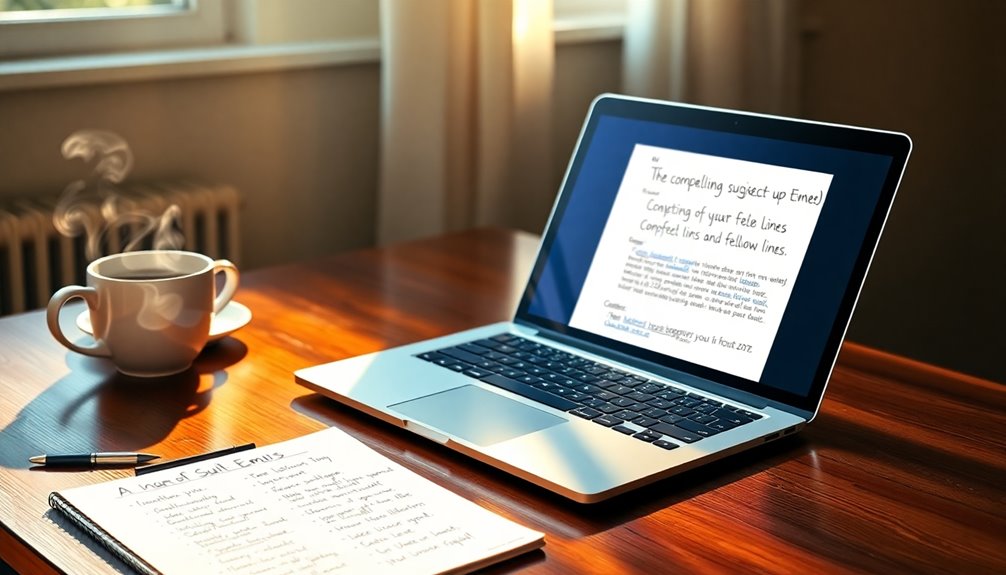
A well-crafted subject line can greatly impact whether your follow-up email gets opened. To grab attention, keep it short and concise—aim for about 7 words or roughly 41 characters. This guarantees that your subject line isn't truncated, especially on mobile devices.
Using a conversational tone is essential. You want to come across as sincere and approachable, so ditch any stiff or formal language. Everyday language will make the recipient feel more comfortable responding.
Creating a sense of urgency or curiosity can also enhance engagement. Phrases like "Missed you again" or "Did you miss it?" hint at time sensitivity without giving everything away, prompting the recipient to open your email. Engaging subject lines lead to higher open rates, making your follow-up emails more effective.
Personalizing your subject line by including the recipient's name or referencing a shared experience adds a nice touch.
Don't forget to optimize the email preview text to relate closely to the subject line, using effective keywords at the beginning for visibility. Keywords like "just," "content," and "wonderful" can boost open rates, so tailor them to fit your context.
Structuring Your Follow-Up
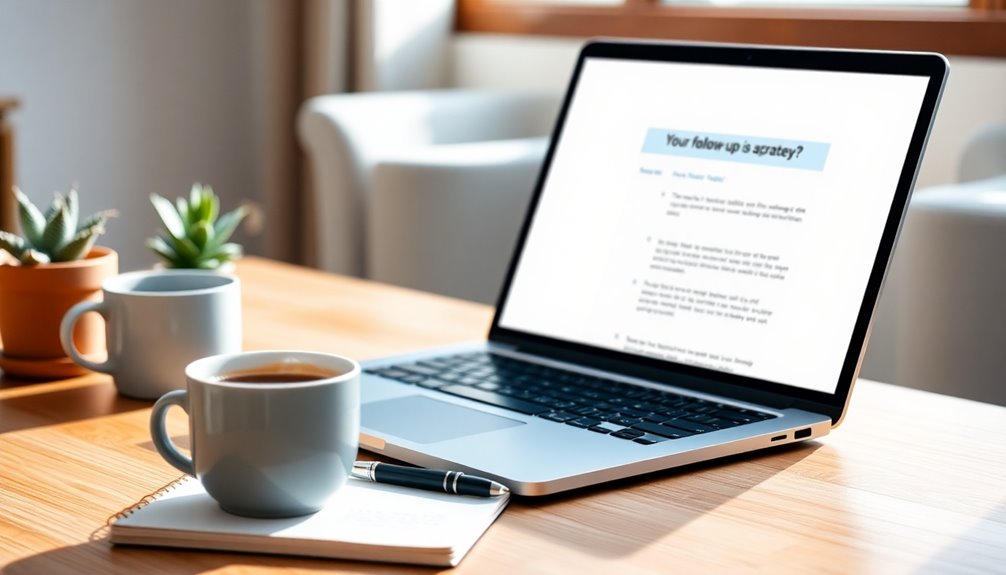
Structuring your follow-up email is essential for guaranteeing your message resonates with the recipient. Start by defining the goal of your email from both your perspective and theirs. Frame it around their needs, and provide context by recapping your previous discussion or meeting. Mention specific topics you covered to jog their memory and establish relevance.
Keep your content concise and clear. Summarize the key points from your past conversation without overwhelming them with lengthy paragraphs. Focus on reminding them of the necessary action instead of rehashing your sales pitch. Using bullet points can help make your email easy to skim. Additionally, the ideal waiting period for the first follow-up email is 3-4 days after the initial interaction, allowing prospects time to consider your proposition. Remember, navigating small mistakes in communication can enhance your overall effectiveness.
To make your email engaging, adopt a conversational tone. Personalize it by addressing the recipient by name and referencing details from your last interaction. This approach shows you value their input and are keen to hear their thoughts.
Finally, include a strong call to action (CTA). Make it clear and specific, guiding them on what to do next. Use action-oriented language, like "Unlock your discount code," and guarantee it's easy for them to execute with just a click. This will increase the chances of a prompt response.
Templates for Different Scenarios
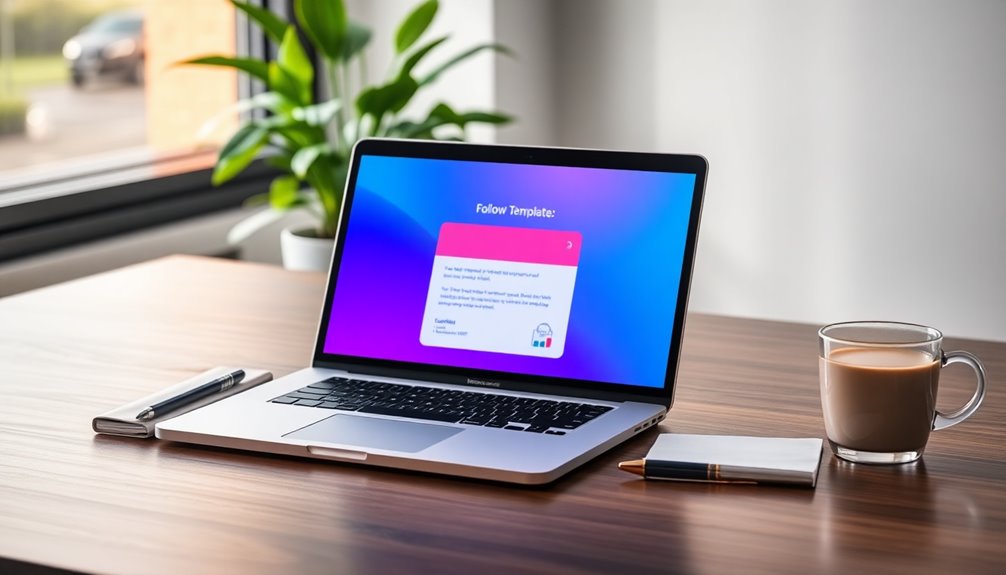
When it comes to follow-up emails, having the right template for different scenarios can make all the difference in your communication. If you're reaching out after not hearing back, use a subject line like "Following up – [Your name]". In the body, gently nudge the recipient, acknowledging their busy schedule, and offer assistance. Send this within 24 to 48 hours of your initial email while maintaining a respectful and polite tone. Timely follow-ups can significantly enhance the likelihood of a response.
After a meeting, your subject line should be "Recap of our meeting – [Your name]". Summarize the key points discussed, outline any agreed-upon action items, and express gratitude for their time. If you promised any documents, attach them for easy reference.
For sales follow-ups, try a subject like "Following up on [Specific product/service]". Highlight how your offering meets their needs, address any questions, and suggest scheduling a call to dive deeper.
Finally, after an event or initial contact, use “Thank you for your time – [Your name]”. Show appreciation, mention specific topics discussed, and propose a follow-up meeting within a specific timeframe. I look forward to further discussing the details of the project and getting closer to finalizing our plans. I’ll follow-up within the next week to coordinate a time for our next meeting. In the meantime, I’ll be promptly crafting a thoughtful thankyou email to express my gratitude for your time and insights during our conversation. Thank you for your time – [Your name].
Each template tailors your message to maximize engagement.
Best Practices for Success

Mastering follow-up emails can greatly enhance your communication effectiveness and boost your response rates. By following best practices, you can guarantee your emails are well-received and prompt action. Here are some key strategies to reflect upon:
- Timing and Frequency: Wait 2-3 days after your initial email for the first follow-up. If there's no response, wait an additional 4-7 days for the second. A final follow-up can be sent after another week.
- Subject Lines and Email Structure: Craft concise, value-based subject lines that grab attention. Keep your emails brief and refer to previous communications for context. Follow-up emails act as reminders and prompts for responses, increasing response rates by 30%.
- Tone and Professionalism: Maintain a polite and professional tone. Thank the recipient for their time, and avoid sounding pushy or overly salesy.
Incorporating these best practices not only increases the likelihood of your emails being opened but also boosts your overall response rates by up to 21%.
Stay consistent with your follow-ups, and always include a clear, low-commitment call to action. This approach will help you establish meaningful connections and achieve better results.
Personalization Techniques
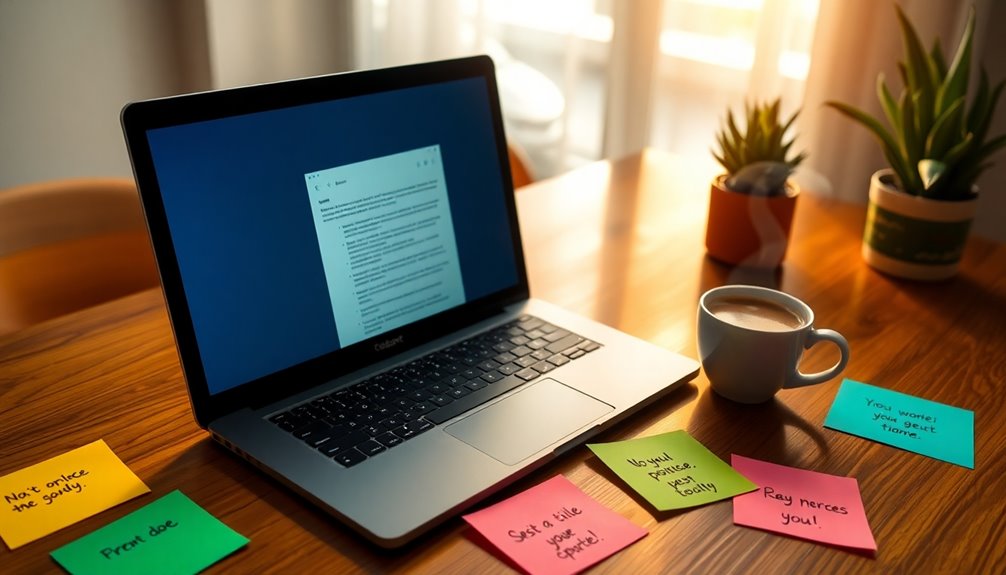
Personalization is key to making your follow-up emails stand out in a crowded inbox. By using recipient data effectively, you can greatly boost your engagement rates. Start by addressing the recipient by name in both the subject line and email body—this simple tactic can increase open rates. Segment your email lists based on demographics, behavior, and purchase history to deliver relevant content. Additionally, personalized emails can capture recipient attention and significantly improve engagement metrics. Establishing a strong online presence can also enhance your brand's online visibility and ensure that your emails are taken seriously.
Here's a quick overview of personalization techniques:
| Technique | Description | Impact |
|---|---|---|
| Name In Subject Line | Use the recipient's name for a personal touch. | Boosts open rates by 26%. |
| Dynamic Content Insertion | Tailor content based on user behavior or location. | Enhances relevance and engagement. |
| Human Touch | Send emails from a real person, not a brand. | Builds a connection and trust. |
Additionally, send timely content based on actions like new subscriptions or abandoned carts. Incorporating personalized recommendations can also enhance the user experience. By leveraging these techniques, you're well on your way to crafting compelling follow-up emails that get results.
Measuring Your Follow-Up Results
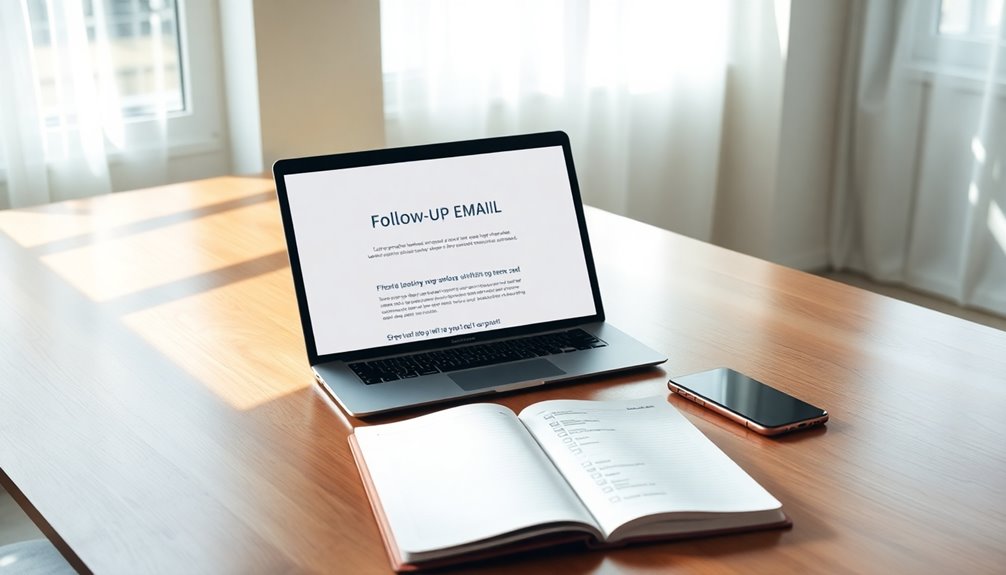
To guarantee your follow-up emails are effective, measuring their performance is essential. Tracking key metrics helps you understand what works and what doesn't, allowing you to refine your strategy.
Here are some important metrics to focus on:
- Open Rates: This tells you how many recipients opened your email. Calculate it by dividing total opens by emails delivered. Pay attention to factors like your subject line and sender name to boost performance. Incorporating data analytics can further enhance your understanding of recipient behavior.
- Click-Through Rates (CTR): This measures the percentage of recipients who clicked a link in your email. Calculate it by dividing total clicks by emails delivered. Optimize anchor text and link placement for better engagement.
- Unsubscribe and Spam Complaint Rates: This indicates how many recipients opted out or marked your email as spam. Calculate it by dividing total unsubscribes or spam complaints by emails delivered. Confirm your content is relevant and frequency is appropriate to reduce these rates. Additionally, tracking open rates can provide insight into initial interest in your follow-up emails.
Frequently Asked Questions
How Often Should I Follow up if I Get No Response?
If you're not getting a response, it's best to follow up 2-3 times.
Start with your first follow-up 2-3 days after your initial email, then wait about a week for the second, and another week or two for the third.
This timing increases your chances of getting a reply without overwhelming the recipient.
Keep your messages brief and include a clear call to action to encourage engagement.
What Tools Can I Use to Automate Follow-Up Emails?
To automate your follow-up emails, you can use tools like Brevo, which offers customizable triggers and SMS options.
Omnisend specializes in ecommerce automations for cart recovery, while MailChimp provides advanced campaign features and integrations.
If you're focused on cold outreach, consider Saleshandy or Woodpecker for personalized sequences.
Constant Contact is also great for simple automations.
Each tool has unique features, so choose one that fits your specific needs and budget.
Should I Personalize Follow-Ups for Different Recipients?
Imagine you're throwing a party, and you invite friends without addressing them by name—how special would they feel?
When you personalize follow-ups, you show recipients they matter. Research shows personalized emails boost engagement by 139% compared to generic ones.
By tailoring your message, you enhance response rates and build trust, making your follow-ups stand out in crowded inboxes.
How Can I Track the Success of My Follow-Up Emails?
To track the success of your follow-up emails, use email tracking tools like GMass or Mailshake.
These tools let you monitor opens and clicks, providing valuable insights into engagement. Look for real-time notifications and integrated dashboards to analyze your email metrics.
Additionally, consider segmenting your audience and personalizing your content to enhance engagement.
Remember to review your data regularly to refine your strategy and improve future follow-up emails.
What Should I Do if My Follow-Up Email Gets No Replies?
If your follow-up email's met with silence, picture it like sending a message in a bottle, floating unanswered across the vast ocean.
Wait a few days, then craft a fresh email, gently reminding them of your last touchpoint. Keep it concise and engaging, adding value or a success story to capture their interest.
Mix up your communication channels; sometimes a different approach can turn the tide and spark a response.
Conclusion
In the fast-paced world we live in, your follow-up email could be the game-changer you need. By applying the strategies outlined, you're not just sending another email; you're opening doors to new opportunities. So, why let your hard work go unnoticed? Take action now, and watch how a well-crafted follow-up can transform your connections into results within 24 hours. Don't just sit back—make your mark today!
Emmeline is the backbone of our content creation team, bringing complex psychological concepts to life with clarity and empathy. As our Expert Writer, she crafts engaging, insightful articles that guide readers through the intricacies of personality assessments and what they reveal about the human condition. Her passion for psychology and personal development shines through in every piece she writes.
